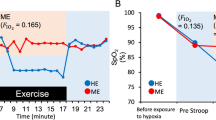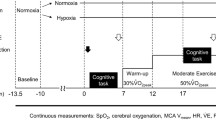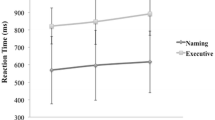Abstract
Purpose
The combined effects of acute hypoxia and exercise on cognition remain to be clarified. We investigated the effect of speed climbing to high altitude on reactivity and inhibitory control in elite climbers.
Methods
Eleven elite climbers performed a speed ascent of the Mont-Blanc (4810 m) and were evaluated pre- (at 1000 m) and immediately post-ascent (at 3835 m). In both conditions, a Simon task was done at rest (single-task session, ST) and during a low-intensity exercise (dual-task session, DT). Prefrontal cortex (PFC) oxygenation and middle cerebral artery velocity (MCAv) were monitored using near-infrared spectroscopy and transcranial Doppler, respectively, during the cognitive task. Self-perceived mental fatigue and difficulty to perform the cognitive tests were estimated using a visual analog scale. Heart rate and pulse oxygenation (SpO2) were monitored during the speed ascent.
Results
Elite climbers performed an intense (~ 50% of the time ≥ 80% of maximal heart rate) and prolonged (8h58 ± 6 min) exercise in hypoxia (minimal SpO2 at 4810 m: 78 ± 4%). Reaction time and accuracy during the Simon task were similar pre- and post-ascent (374 ± 28 ms vs. 385 ± 39 ms and 6 ± 4% vs. 5 ± 4%, respectively; p > 0.05), despite a reported higher mental fatigue and difficulty to perform the Simon task post-ascent (all p < 0.05). The magnitude of the Simon effect was unaltered (p > 0.05), suggesting a preserved cognitive control post-ascent. Pattern of PFC oxygenation and MCAv differed between pre- and post-ascent as well as between ST and DT conditions.
Conclusions
Cognitive control is not altered in elite climbers after a speed ascent to high-altitude despite substantial cerebral deoxygenation and fatigue perception.




Similar content being viewed by others
Data availability
The datasets generated during and/or analyzed during the current study are available from the corresponding author on reasonable request.
Code availability
Not applicable.
Abbreviations
- AMS:
-
Acute mountain sickness
- ANOVA:
-
Analysis of variance
- BL:
-
Baseline
- CaO2 :
-
Oxygen arterial content
- CO:
-
Congruent
- DT:
-
Dual task
- ESM:
-
Electronic supplementary material
- fNIRS:
-
Functional near-infrared spectroscopy
- [Hb]:
-
Hemoglobin concentration
- [HHb]:
-
Deoxyhemoglobin
- [HbO2]:
-
Oxyhemoglobin
- [HbTot]:
-
Total hemoglobin
- HR:
-
Heart rate
- IN:
-
Incongruent
- MCA:
-
Middle cerebral artery
- MCAv:
-
Middle cerebral artery mean velocity
- MCA DO2 :
-
Cerebral oxygen delivery through the middle cerebral artery
- PFC:
-
Prefrontal cortex
- SpO2 :
-
Pulse oxygen saturation
- ST:
-
Single task
- TCD:
-
Transcranial Doppler
- TSI:
-
Tissue oxygen saturation index
References
Ainslie PN, Hoiland RL (2014) Transcranial Doppler ultrasound: valid, invalid, or both? J Appl Physiol 117:1081–1083. https://doi.org/10.1152/japplphysiol.00854.2014
Ainslie PN, Barach A, Murrell C et al (2007) Alterations in cerebral autoregulation and cerebral blood flow velocity during acute hypoxia: rest and exercise. Am J Physiol Heart Circ Physiol 292:H976–H983. https://doi.org/10.1152/ajpheart.00639.2006
Algaze I, Phillips L, Inglis P et al (2020) Incidence of mild cognitive impairment with ascending altitude. High Alt Med Biol 21:184–191. https://doi.org/10.1089/ham.2019.0111
Ando S, Hatamoto Y, Sudo M et al (2013) The effects of exercise under hypoxia on cognitive function. PLoS ONE 8:e63630. https://doi.org/10.1371/journal.pone.0063630
Ando S, Komiyama T, Sudo M et al (2020) The interactive effects of acute exercise and hypoxia on cognitive performance: a narrative review. Scand J Med Sci Sports 30:384–398. https://doi.org/10.1111/sms.13573
Bouzat P, Séchaud G, Banco P et al (2018) The effect of zolpidem on cognitive function and postural control at high altitude. Sleep. https://doi.org/10.1093/sleep/zsy153
Brothers RM, Zhang R (2016) CrossTalk opposing view: the middle cerebral artery diameter does not change during alterations in arterial blood gases and blood pressure: CrossTalk. J Physiol 594:4077–4079. https://doi.org/10.1113/JP271884
Browne SE, Flynn MJ, O’Neill BV, et al (2017) Effects of acute high-intensity exercise on cognitive performance in trained individuals: a systematic review. In: Progress in brain research. Elsevier, pp 161–187
Brugniaux JV, Hodges ANH, Hanly PJ, Poulin MJ (2007) Cerebrovascular responses to altitude. Respir Physiol Neurobiol 158:212–223. https://doi.org/10.1016/j.resp.2007.04.008
Burma JS, Macaulay A, Copeland P et al (2020) Comparison of cerebrovascular reactivity recovery following high-intensity interval training and moderate-intensity continuous training. Physiol Rep 8:e14467. https://doi.org/10.14814/phy2.14467
Davranche K, Audiffren M (2004) Facilitating effects of exercise on information processing. J Sports Sci 22:419–428. https://doi.org/10.1080/02640410410001675289
Davranche K, McMorris T (2009) Specific effects of acute moderate exercise on cognitive control. Brain Cogn 69:565–570. https://doi.org/10.1016/j.bandc.2008.12.001
Davranche K, Brisswalter J, Radel R (2015) Where are the limits of the effects of exercise intensity on cognitive control? J Sport Health Sci 4:56–63. https://doi.org/10.1016/j.jshs.2014.08.004
Davranche K, Casini L, Arnal PJ et al (2016) Cognitive functions and cerebral oxygenation changes during acute and prolonged hypoxic exposure. Physiol Behav 164:189–197. https://doi.org/10.1016/j.physbeh.2016.06.001
De Bels D, Pierrakos C, Bruneteau A et al (2019) Variation of cognitive function during a short stay at hypobaric hypoxia chamber (Altitude: 3842 M). Front Physiol 10:806. https://doi.org/10.3389/fphys.2019.00806
Diamond A (2013) Executive functions. Annu Rev Psychol 64:135–168. https://doi.org/10.1146/annurev-psych-113011-143750
Hamacher D, Brennicke M, Behrendt T et al (2017) Motor-cognitive dual-tasking under hypoxia. Exp Brain Res 235:2997–3001. https://doi.org/10.1007/s00221-017-5036-y
Hoiland RL, Bain AR, Rieger MG et al (2016) Hypoxemia, oxygen content, and the regulation of cerebral blood flow. Am J Physiol-Regul Integr Comp Physiol 310:R398–R413. https://doi.org/10.1152/ajpregu.00270.2015
Imray C, Chan C, Stubbings A et al (2014) Time course variations in the mechanisms by which cerebral oxygen delivery is maintained on exposure to hypoxia/altitude. High Alt Med Biol 15:21–27. https://doi.org/10.1089/ham.2013.1079
Issa AN, Herman NM, Wentz RJ et al (2016) Association of cognitive performance with time at altitude, sleep quality, and acute mountain sickness symptoms. Wilderness Environ Med 27:371–378. https://doi.org/10.1016/j.wem.2016.04.008
Joyce J, Graydon J, McMorris T, Davranche K (2009) The time course effect of moderate intensity exercise on response execution and response inhibition. Brain Cogn 71:14–19. https://doi.org/10.1016/j.bandc.2009.03.004
Komiyama T, Sudo M, Higaki Y et al (2015) Does moderate hypoxia alter working memory and executive function during prolonged exercise? Physiol Behav 139:290–296. https://doi.org/10.1016/j.physbeh.2014.11.057
Komiyama T, Katayama K, Sudo M et al (2017) Cognitive function during exercise under severe hypoxia. Sci Rep 7:10000. https://doi.org/10.1038/s41598-017-10332-y
Lambourne K, Tomporowski P (2010) The effect of exercise-induced arousal on cognitive task performance: a meta-regression analysis. Brain Res 1341:12–24. https://doi.org/10.1016/j.brainres.2010.03.091
Lefferts WK, Babcock MC, Tiss MJ et al (2016) Effect of hypoxia on cerebrovascular and cognitive function during moderate intensity exercise. Physiol Behav 165:108–118. https://doi.org/10.1016/j.physbeh.2016.07.003
Lefferts WK, DeBlois JP, Soriano JE et al (2020) Preservation of neurovascular coupling to cognitive activity in anterior cerebrovasculature during incremental ascent to high altitude. High Alt Med Biol 21:20–27. https://doi.org/10.1089/ham.2019.0050
Leone C, Feys P, Moumdjian L et al (2017) Cognitive-motor dual-task interference: a systematic review of neural correlates. Neurosci Biobehav Rev 75:348–360. https://doi.org/10.1016/j.neubiorev.2017.01.010
Limmer M, Platen P (2018) The influence of hypoxia and prolonged exercise on attentional performance at high and extreme altitudes: a pilot study. PLoS ONE 13:e0205285. https://doi.org/10.1371/journal.pone.0205285
Lu C, Proctor RW (1995) The influence of irrelevant location information on performance: a review of the Simon and spatial Stroop effects. Psychon Bull Rev 2:174–207. https://doi.org/10.3758/BF03210959
McMorris T, Hale BJ (2012) Differential effects of differing intensities of acute exercise on speed and accuracy of cognition: a meta-analytical investigation. Brain Cogn 80:338–351. https://doi.org/10.1016/j.bandc.2012.09.001
McMorris T, Hale BJ, Barwood M et al (2017) Effect of acute hypoxia on cognition: a systematic review and meta-regression analysis. Neurosci Biobehav Rev 74:225–232. https://doi.org/10.1016/j.neubiorev.2017.01.019
Miller EK, Cohen JD (2001) An integrative theory of prefrontal cortex function. Annu Rev Neurosci 24:167–202. https://doi.org/10.1146/annurev.neuro.24.1.167
Ochi G, Yamada Y, Hyodo K et al (2018) Neural basis for reduced executive performance with hypoxic exercise. Neuroimage 171:75–83. https://doi.org/10.1016/j.neuroimage.2017.12.091
Puthon L, Bouzat P, Rupp T et al (2016) Physiological characteristics of elite high-altitude climbers: climbers in hypoxia. Scand J Med Sci Sports 26:1052–1059. https://doi.org/10.1111/sms.12547
Roach RC, Hackett PH, Oelz O et al (2018) The 2018 Lake Louise acute mountain sickness score. High Alt Med Biol 19:4–6. https://doi.org/10.1089/ham.2017.0164
Rupp T, Thomas R, Perrey S, Stephane P (2008) Prefrontal cortex oxygenation and neuromuscular responses to exhaustive exercise. Eur J Appl Physiol 102:153–163. https://doi.org/10.1007/s00421-007-0568-7
Sampson JB, Cymerman A, Burse RL et al (1983) Procedures for the measurement of acute mountain sickness. Aviat Space Environ Med 54:1063–1073
Shoemaker LN, Wilson LC, Lucas SJE et al (2021) Indomethacin markedly blunts cerebral perfusion and reactivity, with little cognitive consequence in healthy young and older adults. J Physiol 599:1097–1113. https://doi.org/10.1113/JP280118
Simon JR (1990) The effects of an irrelevant directional CUE on human information processing. In: Advances in psychology. Elsevier, pp 31–86
Subudhi AW, Miramon BR, Granger ME (1985) Roach RC (2009) Frontal and motor cortex oxygenation during maximal exercise in normoxia and hypoxia. J Appl Physiol Bethesda Md 106:1153–1158. https://doi.org/10.1152/japplphysiol.91475.2008
Taylor L, Watkins SL, Marshall H et al (2016) The impact of different environmental conditions on cognitive function: a focused review. Front Physiol. https://doi.org/10.3389/fphys.2015.00372
Temesi J, Arnal PJ, Davranche K et al (2013) Does central fatigue explain reduced cycling after complete sleep deprivation? Med Sci Sports Exerc 45:2243–2253. https://doi.org/10.1249/MSS.0b013e31829ce379
Verges S, Rupp T, Jubeau M et al (2012) Cerebral perturbations during exercise in hypoxia. Am J Physiol-Regul Integr Comp Physiol 302:R903–R916. https://doi.org/10.1152/ajpregu.00555.2011
Wickens CD, Keller JW, Shaw C (2015) Human factors in high-altitude mountaineering. J Hum Perform Extreme Environ. https://doi.org/10.7771/2327-2937.1065
Willie CK, Colino FL, Bailey DM et al (2011) Utility of transcranial Doppler ultrasound for the integrative assessment of cerebrovascular function. J Neurosci Methods 196:221–237. https://doi.org/10.1016/j.jneumeth.2011.01.011
Wilson MH, Newman S, Imray CH (2009) The cerebral effects of ascent to high altitudes. Lancet Neurol 8:175–191. https://doi.org/10.1016/S1474-4422(09)70014-6
Acknowledgements
We thank the elite climbers from the FFCAM and their coaches for their enthusiastic participation, as well as the staff of the Goûter hut for technical assistance, Julia Roger-Veyer (RN) for expert technical assistance and the Centre national de la recherche scientifique (CNRS) délégation Alpes for the provision of the Vallot Observatory. We thank Thibault Le Roux-Mallouf for his fNIRS technical help. Two elite climbers from the Groupe Excellence National Alpinisme (GEAN), who participated in the study, accidentally passed away during the first ascent of the West face of the Mingbo Eiger (6070 m) in Nepal, during collation of this manuscript. The authors express their sincere condolences to the climbers’ families and friends.
Funding
This study was supported by a grant from the FFCAM (Fédération Française des Clubs Alpins et de Montagne). However, the sponsors had no further involvement in any step of the project.
Author information
Authors and Affiliations
Contributions
BC, KD, JVB, SB, SD, PR, PB and SV designed the study. BC, JVB, SB, SD, PR, PB and SV acquired the data. BC, KD and TG performed the statistical analysis. BC, KD, JVB, SB and SV analyzed and interpreted the data. BC, KD, JVB and SV wrote the manuscript. SB, TG, SD, PR and PB revised it for important intellectual content. All authors gave final approval and agreed to be accountable for all aspects of work ensuring integrity and accuracy.
Corresponding author
Ethics declarations
Conflict of interest
The authors have no conflicts of interest to declare that are relevant to the content of this article.
Ethics approval
This study was performed in line with the principles of the Declaration of Helsinki. Approval was granted by the French Ethics Committee CPP Ouest VI (approval reference number 2019-A01866-51).
Consent to participate
Written informed consent was obtained from all individual participants included in the study.
Consent to publication
The authors affirm that human research participants provided informed consent for publication.
Additional information
Communicated by Guido Ferretti.
Publisher's Note
Springer Nature remains neutral with regard to jurisdictional claims in published maps and institutional affiliations.
The original online version of this article was revised: Electronic supplementary material 2 was originally published with a little error in the footnote of the table S2.
Supplementary Information
Below is the link to the electronic supplementary material.
Rights and permissions
About this article
Cite this article
Champigneulle, B., Davranche, K., Brugniaux, J.V. et al. Effect of a speed ascent to the top of Europe on cognitive function in elite climbers. Eur J Appl Physiol 122, 635–649 (2022). https://doi.org/10.1007/s00421-021-04855-6
Received:
Accepted:
Published:
Issue Date:
DOI: https://doi.org/10.1007/s00421-021-04855-6




